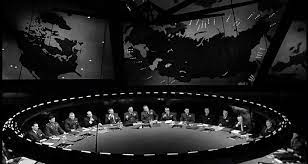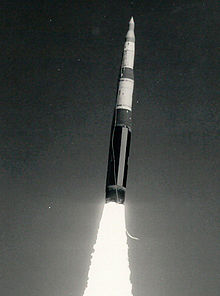Memoir:
NORAD False Alarm
of Soviet Missile Attack
November 9 1979March 30 2006
My personal history is quite a checkered one——meaning, I have some real highs and some real lows. This article describes a high point.
 I spent 5 years in the United States Air Force as enlisted swine, not officer, starting in 1977. In 1980, I was chosen as the Strategic Air Command's "SAC 1980 Outstanding Airman Of The Year". I got there on a combination of BS and real contributions, and I still have certificates and a photo to prove it.
I spent 5 years in the United States Air Force as enlisted swine, not officer, starting in 1977. In 1980, I was chosen as the Strategic Air Command's "SAC 1980 Outstanding Airman Of The Year". I got there on a combination of BS and real contributions, and I still have certificates and a photo to prove it.
Late in 1979, something fairly amazing happened. We edged very close to World War III, due to computer errors on our side.
At the time, I was assigned to SAC Headquarters in Omaha, Nebraska.
In November 1979 I received a phone call from the GS-13 (a fairly high ranking civilian official in SAC HQ) that served in our office, a Mr. Gilbert Karr, somewhere between 1:00 and 2:00 AM if I remember correctly. It might've been an hour later.
In the first part of 1978 I had written a display program that compared computer missile reports from NORAD, headquartered deep within the bowels of Cheyenne Mountain in Colorado Springs, to the brand-new (to SAC) direct electronic message traffic from the various reporting RADAR systems across Alaska and Canada and elsewhere, and from satellite "ground stations" in Australia and elsewhere.
The phone call was a bit disturbing.
"Your program is sporadically flashing displays in the Command Post, showing NORAD reporting 2,020 incoming missiles from the Soviet Union. We know this is incorrect, there's nothing happening politically to cause the Soviets to attack, and it never matches anything from the direct reporting systems from the RADAR systems or the satellite systems."
 I'm talking about the huge projected wall-screen displays in SAC Headquarters. Think "Dr. Strangelove" and its infamous War Room here. I can still close my eyes and picture the underground, concrete-bunkered Command Post in Omaha. It's still there, although no longer SAC.
I'm talking about the huge projected wall-screen displays in SAC Headquarters. Think "Dr. Strangelove" and its infamous War Room here. I can still close my eyes and picture the underground, concrete-bunkered Command Post in Omaha. It's still there, although no longer SAC.
I had transferred out of the section that was responsible for that computer program shortly before Mr. Karr's call.
"Can you come in right now and look at the data feed, to verify that we're actually receiving data traffic from NORAD saying we have incoming missiles?"
My mind spun a bit as I wound through the implications.
"Mr. Karr, Lt. Reese is now really in charge of the program. He should be the one to analyze the message traffic."
"Oh." Mr. Karr sounded extremely disappointed.
A slightly long pause ensued while my mind continued to spin. Lt. Reese was a good guy, but not the sharpest knife in the drawer of our department. And this was obviously a crisis.
"I'm coming in. I have a suggestion, please call Lt. Reese because he's responsible for the program now. It will take me 40 minutes to dress, drive to the base, and get into The Underground. But I think Lt. Reese should be in on this."
Mr. Karr was obviously relieved, and we quickly got off the phone. I couldn't tell my wife anything about what was happening, but as I dressed in uniform she knew that something serious was going on.
![tom_sac.jpg - Photo of Tom Stockman in 1979]() When I arrived at the computer room, Lt. Reese was there in his summer casual short-sleeve uniform, Mr. Karr wearing his usual dark suit and bolo tie.
When I arrived at the computer room, Lt. Reese was there in his summer casual short-sleeve uniform, Mr. Karr wearing his usual dark suit and bolo tie.
I had adopted an affectation for the early-sixties narrow-collar long-sleeve shirt and narrow blue tie uniform, barely still acceptable to Air Force regulations but quite fashionable (at least in my eyes) in the New-Wave Elvis Costello / Joe Jackson days of 1979.
Waiting for me was an inch-thick, 132-character wide stack of green-bar tractor-fed computer paper, representing the computer message feed. I had worked very intensely at processing this data when I wrote the program, so I guess (well, I'm not guessing) that I was the expert.
Mr. Karr seemed very apprehensive. We needed to know if the reports of incoming missiles were from SAC data processing problems or if (hopefully) it was a problem on NORAD's end. Top Generals at SAC had already been called.
I flipped through the pages.
"See this? Here's the begin-of-message signal in OCTAL...here's the end-of-message character...I don't see any problems yet. Wait...wait...OK, here's one reporting incoming missiles. Omigosh (or words meaning approximately that, but not really suitable for a family accessible website)."
I kept flipping, page after page.
 Most of the messages were clean, but occasionally a message would report "32303230"...(you know, it's been a lot of years, and that might've been "32303032")...that OCTAL code translates to the number 2020 (or 2002)...we were sporadically receiving & displaying reports from NORAD saying we had 2020 (or 2002) incoming ICBM nuclear missiles over the north pole from the Soviet Union.
Most of the messages were clean, but occasionally a message would report "32303230"...(you know, it's been a lot of years, and that might've been "32303032")...that OCTAL code translates to the number 2020 (or 2002)...we were sporadically receiving & displaying reports from NORAD saying we had 2020 (or 2002) incoming ICBM nuclear missiles over the north pole from the Soviet Union.
Mr. Karr asked me flat-out, "Can this be a programming error on our part, or is this something from NORAD?" Or as I interpreted it, "Is this our screw-up, or NORAD's?"
And as I looked at the data printouts, I told him that our computer system at SAC was receiving this data. I added a disqualifier that it was conceivable somehow we had false data inserted in the highly secure communication circuits so it might not be truly sourced at NORAD, but I testified that our system was receiving occasional data messages that said we were under missile attack.
After I gave my assessment, I asked Lt. Reese if he agreed. Seeming startled to be asked, he said yes.
And intense investigation by SAC and NORAD over the coming hours confirmed my assessment.
Those reports went to major USAF commands worldwide (and a few other important places). NORAD had an equipment failure, a "data repeater" in their electronic circuits had failed and was changing random bits in some outgoing transmissions. Almost all problem messages got rejected in the communication circuits on "parity checks", only the "32303230" (or was it "32303032"?) messages happened to randomly match on parity and got passed through.
SAC's commanders correctly judged these as completely false reports. But still SAC took heat later from higher authorities because SAC's B-52s hadn't launched. Procedures said they should have, just to have them safely out of harm's way.
 Bombers under the Pacific Air Command (aka PAC) over the Pacific Ocean were circling in the air, fully loaded with nukes, ready to go. USAF procedures prevented them from executing their bombing runs without final authorization.
Bombers under the Pacific Air Command (aka PAC) over the Pacific Ocean were circling in the air, fully loaded with nukes, ready to go. USAF procedures prevented them from executing their bombing runs without final authorization.
Some months later, a technician at NORAD ran a test tape of a nuclear attack, but didn't switch their system to test mode——SAC got reports of incoming, this time a believable series of escalating numbers, not sporadic flashes——once again we could have gone to World War III except SAC could now compare NORAD reports to the detecting systems' direct feeds.
I strongly suspect the first event was a real divine blessing, as the sporadically flashing screens were a tip-off of a glitch. This second incident was a much more realistic scenario and was not sporadic, but USAF Commands worldwide were much more on-guard against NORAD reporting errors.
Responsibility for missile warning in the USA military was taken away from NORAD and given to SAC for something like a year, but NORAD did some housecleaning and soon was again in charge of their mission of monitoring for enemy attacks while SAC went back to their mission, in charge of two of the three "legs" of the USA's Triad of strategic nuclear response (our fleet of bombers and the ICBM missiles, the third being the Navy's fleet of submarines carrying nukes aka SLBMs).
Having the ability to compare NORAD's reports against the data feeds from the actual reporting systems, at SAC, also kept the USA from starting a nuclear holocaust. If I hadn't been there to write that program, somebody else would've been given the assignment.
And, I did my part, and I'm proud of it.
|